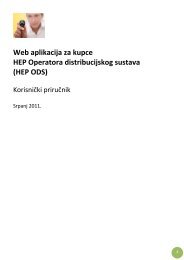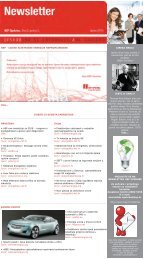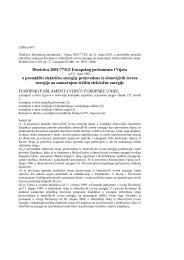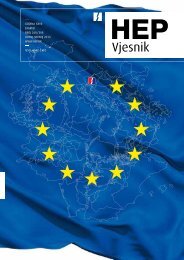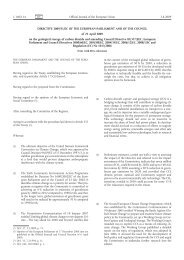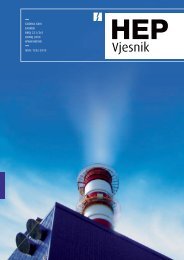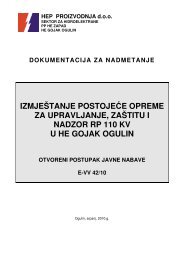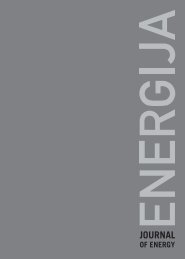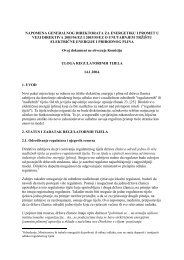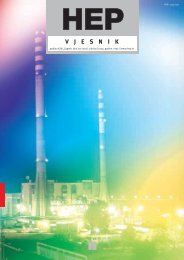Create successful ePaper yourself
Turn your PDF publications into a flip-book with our unique Google optimized e-Paper software.
minimalnom postavljenom cilju kad je rijeË o<br />
razvoju kogeneracija topline i elektriËne energije,<br />
a to Êe postati svojevrsno vanjsko ograniËenje za<br />
sve zemlje Ëlanice.<br />
4.3 OgraniËenje sigurnosti opskrbe<br />
Sigurnost isporuke elektriËne energije moæe se<br />
ostvariti na razliËite naËine: maksimalnim razvojem<br />
proizvodnje iz nacionalnih izvora ili izvora u kojima<br />
je nacionalni udio najveÊi, uz diversifikaciju<br />
koriπtenih izvora i/ili zona opskrbe, sklapanjem<br />
sporazuma i razvojem trgovaËkih odnosa s dobavljaËima<br />
itd. Dakle, nema jednostavnog naËina<br />
kojim bi se moglo definirati ograniËenje koje bi na<br />
zadovoljavajuÊi naËin moglo zajamËiti potpunu<br />
sigurnost opskrbe. S time u svezi mogu se razviti<br />
razliËiti pokazatelji stupnja diversifikacije. Mogla<br />
bi se, primjerice, utvrditi minimalna vrijednost<br />
Herfindahlovog indeksa ili pak maksimalna kvota<br />
elektriËne energije proizvedene iz pojedinaËnog<br />
uvezenog izvora.<br />
U svakom sluËaju, da bi se moglo raspolagati<br />
operativnim ograniËenjem Parlament ili Vlada bi<br />
trebali za to preuzeti izriËitu odgovornost. Do toga,<br />
meappleutim, nikad nije doπlo, a Ëini se da niti ubuduÊe<br />
takvo πto se ne moæe oËekivati. Stoga, kriterij<br />
sigurnosti isporuke (opskrbe) koji se moæe dovesti<br />
u spregu s nastojanjima u smislu diversifikacije<br />
izvora, koristit Êe se samo u kvalitativnom smislu.<br />
Drugim rijeËima, mora se priznati kako je u ovome<br />
sluËaju rijeË o ograniËenju koje je mnogo slabije<br />
definirano od onih prethodnih. S druge pak<br />
strane treba imati u vidu kako zbog pripadnosti<br />
Europskoj uniji, isti instrumenti koji se koriste<br />
za osiguranje poπtivanja ovog ograniËenja moraju<br />
biti kompatibilni s europskim propisima koji sve<br />
viπe suæavaju koncepciju Ëisto nacionalne naravi<br />
problema sigurnosti opskrbe.<br />
4.4 Financijsko ograniËenje<br />
Ekoloπka, energetska i sigurnosna ograniËenja<br />
mogu znaËajnije povisiti proizvodni troπak dobave<br />
elektriËne energije ako ciljevi smanjenja πtetnog<br />
utjecaja na okoliπ i razvoja obnovljivih izvora<br />
energije postanu ambiciozniji. Ako se joπ i usvoji<br />
sustav financijskih poticaja kako bi se postavljeni<br />
ciljevi ostvarili, moæe se dogoditi da potrebni<br />
iznosi probiju dræavni proraËun ili su pak takvi<br />
da ih potroπaËi elektriËne energije nisu spremni<br />
platiti. Naime, ako zbog jednostavnosti uzmemo<br />
primjer ograniËenja proizvodnje odreappleene ukupne<br />
koliËine elektriËne energije iz poticanih izvora<br />
imat Êemo:<br />
The European Union is also clearly oriented toward<br />
a specific minimum established goal regarding<br />
the development of the cogeneration of thermal<br />
and electrical energy, which will serve as a type of<br />
external limitation for all the member states.<br />
4.3 Limitation on the security of supply<br />
The security of the delivery of electrical energy can<br />
be achieved in various ways: through the maximum<br />
development of production from national sources or<br />
sources in which the national share is the greatest,<br />
together with diversification of the sources used<br />
and/or the supply zones, entering agreements and<br />
developing commercial relations with suppliers<br />
etc. Thus, there is no simple manner for defining<br />
the limitations that would satisfactorily guarantee<br />
complete security of supply. In connection with<br />
this, various indices can be used for the degree of<br />
diversification. For example, it would be possible<br />
to determine the minimum value of the Herfindahl<br />
index or the maximum quota of electrical energy<br />
generated from an individual imported source.<br />
In any case, in order to allocate the operative<br />
limitations of the Parliament or Government, it<br />
would be necessary to take specific responsibility.<br />
However, it never came to that and it appears that<br />
something like this cannot be expected in the<br />
future. Therefore, the criteria for the security of<br />
delivery (supply) which can be linked to attempts in<br />
the sense of the diversification of sources, will only<br />
be used in the qualitative sense. In other words, it<br />
must be admitted that this concerns a limitation<br />
that is much more poorly defined than the previous<br />
ones. On the other side, it is necessary to bear in<br />
mind that due to membership in the European<br />
Union, the same instruments that are used for<br />
assuring compliance with these limitation must also<br />
be compatible with the European regulations that<br />
are increasingly narrowing the concept of the purely<br />
national nature of the security of supply.<br />
4.4 Financial limitation<br />
Environmental, energy and security limitations can<br />
significantly increase the production cost of the<br />
energy supply if the goals for reducing detrimental<br />
environmental impact and the development of<br />
renewable energy sources become more ambitious.<br />
If a system of financial incentives is also adopted in<br />
order to achieve the set goals, it could happen that<br />
the necessary amounts exceed the state budget or<br />
are such that the consumers of electrical energy are<br />
not prepared to pay. If, for purposes of simplicity, we<br />
take an example of the limitation of the production<br />
of certain total quantities of electrical energy from<br />
the promoted sources, we obtain the following:<br />
343<br />
De<br />
Paoli, L., ViπkoviÊ, A., Javna potpora razvitku obnovljivih..., Energija, god. 56(2007), br. 3., str. 328∑345<br />
De Paoli, L., ViπkoviÊ, A., Public support for the development..., Energija, vol. 56(2007), No. 3, pp. 328∑345



